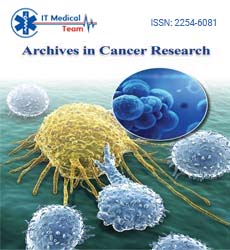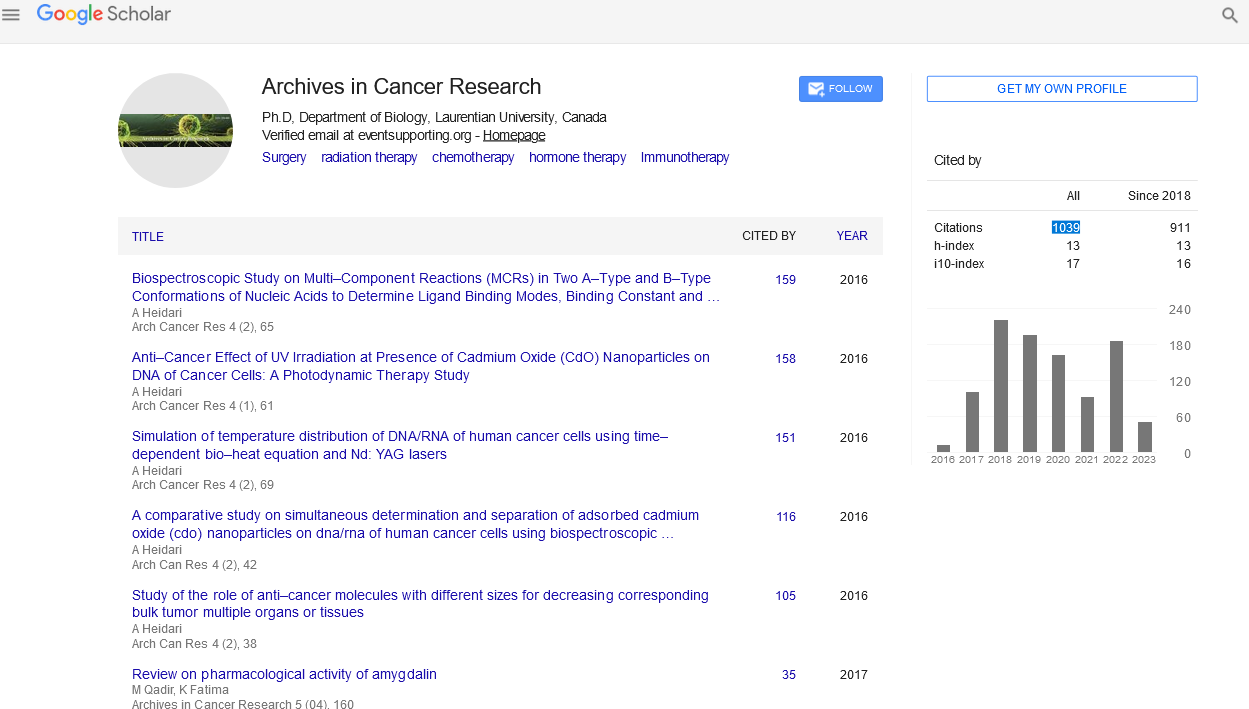Mini Review - (2023) Volume 11, Issue 4
Cancer treatment landscape in India
Kelvin Xavier*
Department of Medicine and Health, the University of Sydney, Sydney, Australia
*Correspondence:
Kelvin Xavier, Department of Medicine and Health, the University of Sydney, Sydney,
Australia,
Email:
Received: 01-Jul-2023, Manuscript No. ipacr-23-13973;
Editor assigned: 03-Jul-2023, Pre QC No. P-13973;
Reviewed: 17-Jul-2023, QC No. Q-13973;
Revised: 22-Jul-2023, Manuscript No. R-13973;
Published:
28-Jul-2023
Abstract
Cancer treatment comes in a variety of forms. Your cancer's kind and degree of advancement will determine the sort of treatment you get. Some cancer patients receive just one therapy. The majority of patients, however, have several therapies, such as surgery along with chemotherapy and/or radiation therapy. Immunotherapy, targeted treatment, and hormone therapy are other options. Cancer is a condition in which a few of the body's cells grow out of control and spread to other bodily regions. The human body, which contains billions of cells, may develop cancer practically everywhere. Human cells often divide to create new cells as needed by the body. This process is known as cell growth and multiplication. A new cell replaces an old one when it dies or is damaged. Sometimes, this systematic process fails, causing damaged or aberrant cells to proliferate when they shouldn't. tumours, which are tissue masses, might develop from these cells. Tumours can be malignant or not (benign).
Keywords
Cancer; Treatment; Immunotherapy; Cancer diagnoses;
Screening
INTRODUCTION
India's population is primarily concentrated in rural
areas. However, there is a substantial discrepancy between
demand and availability for healthcare in India's rural
areas. Lack of basic infrastructure prevents many district
hospitals and even regional cancer centres from offering
high-quality cancer care. Because there are few substantial
cancer centres, most of which are in major cities, a sizable
fraction of affected individuals must travel long distances to
access them. The patient's financial burden is considerably
increased by this movement, and the cancer centres’ ability
to give effective care is hampered by the unbalanced
patient load. India has a high incidence to mortality ratio
when compared to the industrialized countries. Less than
30% of cancer patients live for five or more years after
being diagnosed. One of the main causes of the nation's
inadequate access to cancer care is the lack of timely and
cheap cancer diagnoses, as well as the high cost of cancer
treatments and the disparity between urban and rural
areas. The major point of India's cancer treatment system
is a lack of infrastructure and human resources. Overall, a
key hurdle is the density and dispersion of trained primary
and secondary healthcare staff. There is a startling disparity
in the country's doctor population distribution, with
metropolitan regions having 4 times as many physicians
as rural ones. Cancer patients in India frequently need to
consult a medical oncologist for palliative treatment due
to their advanced stage of disease. Less than 350 medical
oncologists are thought to treat an astonishing 3000 new
cases annually, mostly in private settings. Along with the
lack of human resources, the nation lacks the necessary
physical infrastructure to provide optimum cancer care [1-5].
Although the causes of the incidence's sharp increase
are multifaceted, population growth and aging may
be experimentally linked to it. Importantly, rising
risk behaviours like poor eating habits, inactivity, and
hazardous alcohol and cigarette use all contribute to the
increase in instances. Around 70% of cancer-related
fatalities, according to the World Health Organization
(WHO), take place in low- and middle-income nations.
More than half of fatalities in India are attributable to noncommunicable
diseases (NCDs), with cancer being one of
the main causes. The burden of cancer-related morbidity
and death in the nation is growing, and factors such as latestage
presentation, limited access to appropriate diagnosis
and treatment, and cost all contribute to this trend. The
gaps in cancer care have grown even worse with the current
COVID-19 epidemic. Patient outcomes are likely to be
affected both directly and indirectly by changes in healthseeking
behaviour as well as the accessibility and availability of critical services from screening through treatment. It is
crucial to raise public knowledge of prevention, especially
given the nation's resource constraints. Patients who are
less likely to recognize cancer symptoms and warning signs
are more likely to wait longer to seek medical attention.
Furthermore, psychological obstacles like anxiety, fear,
and stigma have a significant impact on the behaviour of
those seeking assistance. There is evidence to support the
claim that the Indian people have little knowledge about
screening's accessibility.
The diagnosis's stage has a significant impact on the course
of treatment and long-term prognosis. In primary care
settings, cancers are often found or at least assumed to
exist. General practitioners (GPs) serve as "gatekeepers" by
determining early presentations, gauging presymptomatic
risk, compiling crucial patient data, and making decisions
about further research or referrals. However, GPs lack the
education and tools necessary to recognize malignancies
in their early stages or to analyse data from a patient's
presentation. This lack of knowledge among the general
population and primary care professionals may account for
the advanced disease state at diagnosis that is frequently
seen in cancer patients in India.
There are several methods and medications for treating
cancer, and many more are being researched. Some
therapies, like as surgery and radiation therapy, are "local"
and are used to treat a particular tumour or region of the
body. Because they can have an impact on the entire body,
drug therapies (such as chemotherapy, immunotherapy, or
targeted therapy) are sometimes referred to as "systemic"
treatments. The most typical cancer treatment options here.
1. Surgery
2. Chemotherapy
3. Radiation treatment
4. Targeted Treatment
5. Immunotherapy
6. Bone marrow or stem cells
7. Hormone Replacement Therapy
Primary treatment is to completely remove the cancer from
your body or kill all the cancer cells. Any cancer treatment
can be used as a primary treatment, but the most common
primary cancer treatment for the most common types of cancer is surgery. If your cancer is particularly sensitive to
radiation therapy or chemotherapy, you may receive one of
those therapies as your primary treatment [6-8].
In order to lessen the likelihood that the cancer may recur,
adjuvant therapy involves eliminating any cancer cells
that could still be present after initial treatment. Adjuvant
therapy can be used to any cancer treatment. Chemotherapy,
radiation therapy, and hormone therapy are examples of
common adjuvant treatments. Neoadjuvant therapy is
similar, but it involves administering medications before to
the primary therapy in an effort to facilitate or improve the
effectiveness of the latter [9,10].
Palliative care can help with cancer-related symptoms as well
as adverse effects from therapy. Symptom relief techniques
include hormone treatment, chemotherapy, radiation, and
surgery. Other drugs may help with symptoms including
pain and breathlessness. Palliative care can be administered
along with other cancer-curing procedures.
CONCLUSION
Making cancer treatment inexpensive requires pragmatic
cancer care guidelines that encourage the best possible
use of resources and minimize excessive dependence on
and consumption of tests. Across the spectrum of cancer
treatment, an evidence-based strategy with the deployment
of harmonised and standardized clinical protocols should
be encouraged. The optimum use of treatment resources
should be taught to medical professionals and support
employees without sacrificing patient safety or service
quality. To eventually become less resource-intensive, more
thorough, and more precise, they should integrate early
diagnosis with precision medicine. Palliative care should
begin as early as feasible in the patient's medical journey and
be provided for the duration of the illness. Palliative care
should take a comprehensive, multidisciplinary approach
and address the patient's psychological, emotional, coping,
and caregiver needs in order to enhance their overall
quality of life. During or after cancer treatment, digitally
driven patient support programs can successfully augment
outpatient care with in-home care, such as that needed for
pain management or rehabilitation.
REFERENCES
- Hage WD, Aboulafia AJ, Aboulafia DM. Incidence, location, and diagnostic evaluation of metastatic bone disease. Orthop Clin North Am. 2000; 31(7): 515-528.
Indexed at, Google Scholar, Crossref
- Forsberg JA, Sjoberg D, Chen QR, et al. Treating metastatic disease: Which survival model is best suited for the clinic? Clin Orthop Relat Res. 2013; 471(6): 843-850.
Indexed at, Google Scholar, Crossref
- Kachnic LA, Pugh SL, Tai P, et al. RTOG 0518: Randomized Phase III Trial to Evaluate Zoledronic Acid for Prevention of Osteoporosis and Associated Fractures in Prostate Cancer Patients. Prostate Cancer Prostatic Dis. 2013; 16(2): 1-10.
Indexed at, Google Scholar, Crossref
- Kumar S, Kashyap P. Antiproliferative activity and nitric oxide production of amrthanolic extract of Fraxicus micrantha on michigan cancer foundation-7 mammalian breast cancinoma cell line. J Intercult Ethnopharmacol. 2015; 4(8): 109-113.
Indexed at, Google Scholar, Crossref
- Coleman RE, Lipton A, Roodman GD, et al. Metastasis and bone loss: advancing treatment and prevention. Cancer Treat Rev. 2010; 36(9): 615-620.
Indexed at, Google Scholar, Crossref
- Ruggieri P, Mavrogenis AF, Casadei R, et al. Protocol of surgical treatment of long bone pathological fractures. Injury. 2010; 41(6): 1161-1167.
Indexed at, Google Scholar Crossref
- Selvaggi G, Scagliotti GV. Management of bone metastases in cancer: a review. Critical reviews in oncol hematol. 2005; 56(8): 365-378.
Indexed at, Google Scholar, Crossref
- Bauer HC. Controversies in the surgical management of skeletal metastases. J Bone Joint Surg Br. 2005; 87(7): 608-617.
Indexed at, Google Scholar, Crossref
- Kachnic LA, Pugh SL, Tai P, et al. RTOG 0518: Randomized Phase III Trial to Evaluate Zoledronic Acid for Prevention of Osteoporosis and Associated Fractures in Prostate Cancer Patients. Prostate Cancer Prostatic Dis. 2013; 16(2): 1-10.
Indexed at, Google Scholar, Crossref
- Toma CD, Dominkus M, Nedelcu T, et al. Metastatic bone disease: a 36-year single centre trend-analysis of patients admitted to a tertiary orthopaedic surgical department. J Surg Oncol. 2007; 96(5): 404-410.
Indexed at, Google Scholar, Crossref





